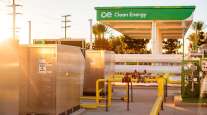Makers See Nat Gas Pricing Critical to Fuel’s Success
This story appears in the Dec. 3 print edition of Transport Topics.
ARLINGTON, Va. — Favorable economics stemming from the vast domestic supply of natural gas will accelerate the trucking industry’s use of the fuel, producers of that fuel said here last week.
While there might be some fleets making their fuel choices based on a desire to reduce the nation’s dependence on foreign oil, or to cut greenhouse gases, “the other 99%” make that choice based on economics, Richard Kolodziej, president of NGVAmerica, told attendees of American Trucking Associations’ Summit on Natural Gas in Trucking here Nov. 29.
Richard Germain, manager of technology ventures at Conoco-Phillips, described a paradigm shift in natural gas exploration and extraction that has dramatically altered the pricing outlook for the fuel.
Back in 2005, the conventional wisdom was that natural gas prices would remain high and the supply would become more and more limited, he said.
But now explorers have found abundant “unconventional” resources for the fuel, including more than a dozen areas that are active and becoming active, such as the Bakken, Eagle Ford and Marcellus shales, Germain said.
These reservoirs produce more than 30% of the industry’s supply today and are expected to produce 60% by 2030, he said. As recently as 2000, these areas were producing very little natural gas.
Drillers are now tapping into “source rock” through hydraulic fracturing and horizontal drilling — a relatively low-cost technique whereby a mixture of water, sand and chemical additives is pumped into the ground to fracture rock formations and release a reservoir of natural gas for extraction.
“In just 10 years, we’ve gone from thinking that the natural-gas supply was in irreversible decline and we would need to be importing vast amounts of LNG . . . to the point where we now think we have up to 100 years of domestic supply of gas,” Germain said.
LNG is liquefied natural gas, which occurs when natural gas is chilled to at least minus 260 degrees Fahrenheit; it is thought of as the choice form of the fuel for heavy-duty trucks making longer hauls.
“We’ve got our eyes on several major trucking markets,” Germain said, announcing that ConocoPhillips’ plan to develop regional supplies of LNG, starting in Dallas.
Its LNG production facility initially will put out about 30 million gallons per year and can be operational within two years, Germain said, but demand will determine when the plant opens. “We’re ready to build when we have the confidence the fuel is needed,” he said.
Ronald Jibson, chairman and CEO of Questar Corp., Salt Lake City, pointed out the United States has lagged behind much of the world in the adoption of natural-gas vehicles.
Worldwide, more than 15 million of the natural-gas fueled vehicles are on the road, but only about 137,000 of them are in the United States, he said.
“We’ve got a lot of room to grow,” said Jibson, who is also the incoming chairman of the American Gas Association.
That picture will change, he said he believes, in part because of equipment and engine manufacturers’ initiatives and an increasing emphasis on clean air.
“I know we’re going to start to see that needle move, and nowhere is there a greater savings than there is in the large trucking industry,” he said.
Kolodziej, whose organization promotes development of a market for natural gas-powered vehicles in the United States, noted that natural-gas vehicles cost more to buy or convert than those using traditional fuels, but they cost much less to operate.
He said natural gas is now selling for the energy equivalent of $28 per barrel of crude oil, which translates to savings of $1.50 to $2 per gallon at the pump.
Carriers can recover the higher purchase price of natural-gas equipment “pretty quickly, if you’re a big trucker and you’re using a lot of fuel,” Kolodziej said.
“All forecasts are predicting that natural gas will stay at a very, very reasonable price through the next 20 to 30 years,” he added.
Natural gas first emerged as a viable fuel in the 1930s, but relatively low world petroleum prices prevented widespread adoption. Refined hydraulic fracturing techniques, however, have unlocked an abundant, inexpensive fuel source in natural gas.
Industry watchers project that a 100-year supply of natural gas can be extracted from American land.
“This is going to be the diesel fuel of the future,” Kolodziej said, noting that the availability of natural-gas vehicles, the expansion of fueling infrastructure and public policy have all “lined up for us now like never before.”




